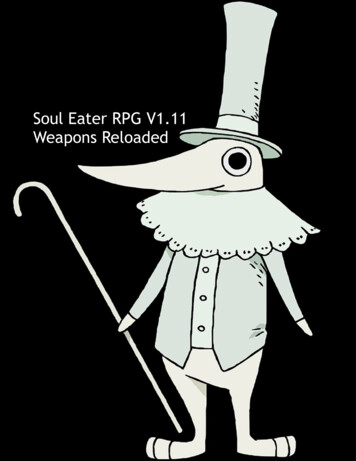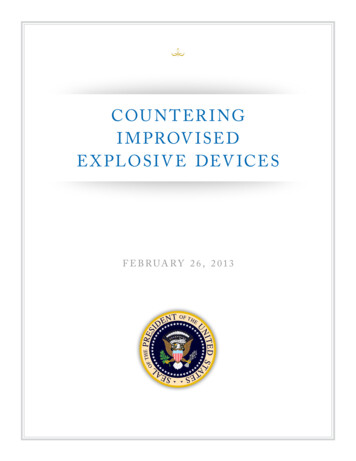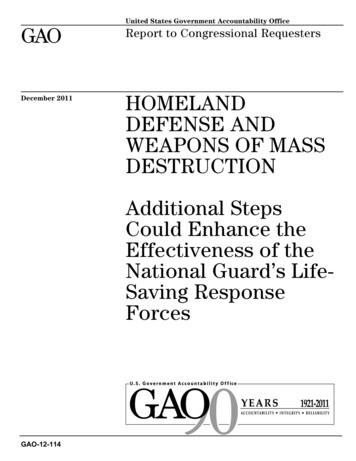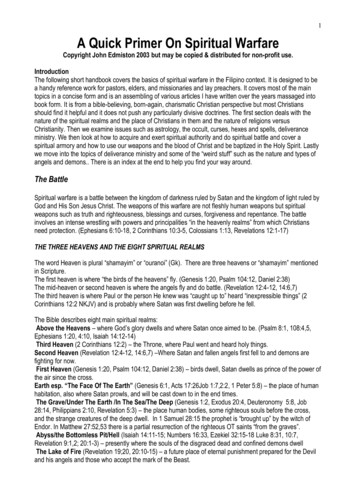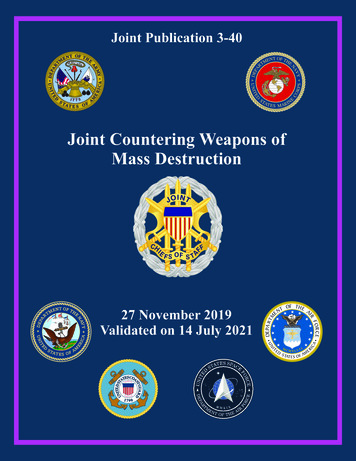
Transcription
ENTTMHIT OF T HS W E' L LDEFEENDARDSTMTEERU NII CA MY DE PARJoint Publication 3-40AT E S O FAJoint Countering Weapons ofMass Destruction27 November 2019Validated on 14 July 2021
PREFACE1. ScopeThis publication provides fundamental principles and guidance to plan, execute, andassess military activities to counter weapons of mass destruction.2. PurposeThis publication has been prepared under the direction of the Chairman of the JointChiefs of Staff (CJCS). It sets forth joint doctrine to govern the activities and performanceof the Armed Forces of the United States in joint operations, and it provides considerationsfor military interaction with governmental and nongovernmental agencies, multinationalforces, and other interorganizational partners. It provides military guidance for the exerciseof authority by combatant commanders and other joint force commanders (JFCs), andprescribes joint doctrine for operations and training. It provides military guidance for useby the Armed Forces of the United States, in preparing and executing their plans and orders.It is not the intent of this publication to restrict the authority of the JFC from organizingthe force and executing the mission in a manner the JFC deems most appropriate to ensureunity of effort in the accomplishment of objectives.3. Applicationa. Joint doctrine established in this publication applies to the Joint Staff, commandersof combatant commands, subordinate unified commands, joint task forces, subordinatecomponents of these commands, the Services, the National Guard Bureau, and combatsupport agencies.b. This doctrine constitutes official advice concerning the enclosed subject matter;however, the judgment of the commander is paramount in all situations.c. If conflicts arise between the contents of this publication and the contents of Servicepublications, this publication will take precedence unless the CJCS, normally incoordination with the other members of the Joint Chiefs of Staff, has provided more currentand specific guidance. Commanders of forces operating as part of a multinational (alliancei
Prefaceor coalition) military command should follow multinational doctrine and proceduresratified by the United States. For doctrine and procedures not ratified by the United States,commanders should evaluate and follow the multinational command’s doctrine andprocedures, where applicable and consistent with US law, regulations, and doctrine.For the Chairman of the Joint Chiefs of Staff:DANIEL J. O’DONOHUELieutenant General, USMCDirector, Joint Force DevelopmentiiJP 3-40
SUMMARY OF CHANGESREVISION OF JOINT PUBLICATION 3-40DATED 31 OCTOBER 2014 This publication was validated without change on 14 July 2021. Updates and aligns the countering weapons of mass destruction (CWMD)doctrine for the joint force with major changes to Department of Defense(DOD) policy, strategy, and planning guidance for CWMD. Highlights the DOD strategy for CWMD as the underpinning for CWMDguidance. Introduces the weapons of mass destruction activity continuum. Introduces the operational framework for CWMD that consists of threeorganizing principles (prevent, protect, and respond) carried out throughspecialized activities (pathway defeat; weapons of mass destruction [WMD]defeat; and chemical, biological, radiological, and nuclear [CBRN] response). Describes the organizing principles: prevent, protect, and respond. Defines the specialized activities: pathway defeat, WMD defeat, and CBRNresponse. Describes the specialized tasks associated with each specialized activity andorganizing principle. Describes the role of the functional campaign plan for CWMD, integratingDOD-wide efforts to prevent the use, acquisition, and proliferation of WMD;prepare the joint force to respond to WMD crises; and assure allies andpartners. Describes the relationship between military organizations and functions toother US Government departments and agencies and international partners.iii
Summary of ChangesIntentionally BlankivJP 3-40
TABLE OF CONTENTSEXECUTIVE SUMMARY . viiCHAPTER IINTRODUCTION General . I-1Countering Weapons of Mass Destruction Policy and Strategy . I-1Relationship to the Joint Functions. I-6Countering Weapons of Mass Destruction Doctrine Relationship toOther Doctrine . I-7CHAPTER IIOPERATIONAL ENVIRONMENT AND OPERATIONAL FRAMEWORK General .II-1Weapons of Mass Destruction Activity Continuum .II-1Weapons of Mass Destruction Supply and Demand Networks .II-4Weapons of Mass Destruction Actors of Concern .II-4Chemical, Biological, Radiological, and Nuclear Environment.II-5Operational Framework .II-7CHAPTER IIIPLANNING General . III-1The Competition Continuum and Countering Weapons of Mass DestructionAcross the Range of Military Operations . III-1General Countering Weapons of Mass Destruction Planning Guidance . III-4Campaign and Operational Design for Countering Weapons of MassDestruction Planning . III-5Department of Defense Functional Campaign Plan Countering Weapons of Mass Destruction Integration . III-5Countering Weapons of Mass Destruction Strategic Approach for Planning . III-5Planning Considerations . III-6CHAPTER IVEXECUTION General . IV-1Countering Weapons of Mass Destruction Activities and Tasks . IV-1Foundational and Crosscutting Activities and Tasks. IV-2Organizing Principles and Specialized Activities and Tasks . IV-5v
Table of ContentsAPPENDIXABCDEFGHOrganizational and Command Relationships . A-1Treaties, Resolutions, Activities, and Legal Considerations .B-1Weapon Characteristics .C-1Dual-Use Challenges . D-1Science and Technology. E-1Points of Contact . F-1References . G-1Administrative Instructions . H-1GLOSSARYPart IPart IIAbbreviations, Acronyms, and Initialisms . GL-1Terms and Definitions . -3D-4D-5D-6D-7D-8D-9D-10D-11D-12E-1E-2viNational Defense Strategic Approach . I-4Weapons of Mass Destruction Activity Continuum .II-3Weapons of Mass Destruction Development Framework.II-8Countering Weapons of Mass Destruction Activities and Tasks . IV-2Prevent (Pathway Defeat) Specialized Tasks . IV-5Protect (Weapons of Mass Destruction Defeat) Specialized Tasks . IV-7Respond (Chemical, Biological, Radiological, and Nuclear Response)Specialized Tasks . IV-11Agents with Significant Risks of Deliberate Misuse .C-4Chemical Weapons Production .C-5Dual-Use Chemical/Biological Applications . D-1Chemical Reactor Vessel . D-2Chemical Storage Tanks. D-3Chemical Heat Exchanger . D-4Chemical Distillation Column . D-5Chemical Filling Equipment . D-6Chemical Valve . D-7Chemical Pressing Piping. D-9Chemical Production Pumps . D-10Biological Production Fermenter . D-11Biological Production Fermenter . D-12Biological Production Filtration . D-13Science and Technology Trends . E-2Chemical and Biological Advancements . E-4JP 3-40
EXECUTIVE SUMMARYCOMMANDER’S OVERVIEW Outlines countering weapons of mass destruction policy and strategy Discusses countering weapons of mass destruction activities and operationsrelation to the joint functions Describes the operational environment and operational framework Outlines a countering weapons of mass destruction strategic approach forplanning Examines how foundational and crosscutting activities and tasks, along withspecialized tasks within and across the countering weapons of massdestruction organizing principles, logically group tasks to prevent or counterspecific weapons of mass destruction threatsIntroductionThe US, its partners, and allies face an increasing weaponsof mass destruction (WMD) threat from actors of concernwho operate transregionally, conduct activities ifunctionally organized. Countering weapons of massdestruction (CWMD) is a national security priority thatrequires a coordinated, whole-of-government approach thatbrings all instruments of national power to bear againstthese actors and their WMD-related activities. TheDepartment of Defense (DOD) contributes to the UnitedStates Government (USG) effort by providing joint forcesthat plan and execute tasks to ensure the US, its forces, andpartners are neither coerced nor attacked with WMD.WMD are chemical, biological, radiological, and nuclear(CBRN) weapons capable of a high order of destruction orcausing mass casualties, excluding the means oftransporting or propelling the weapon where such means isa separable and divisible part from the weapon.Countering Weapons ofMass Destruction Policyand StrategyThe President provides policy and strategy for USGdepartments and agencies to ensure unified effort in the2017 National Security Strategy of the United States ofAmerica [short title: National Security Strategy (NSS)],Nationalvii
Executive SummaryStrategy for Countering Weapons of Mass DestructionTerrorism, Presidential directives, and other plans andorders.DOD derives its national strategic direction primarily fromthe President’s guidance in the NSS, presidential directives,and other national strategic documents, in conjunction withthe National Security Council and the Homeland SecurityCouncil. The (U) 2018 National Defense Strategy of theUnited States of America: Sharpening the AmericanMilitary’s Competitive Edge [short title: National DefenseStrategy] is DOD policy that refines the strategic directionof the NSS for DOD.Relationship to the JointFunctionsCWMD activities and operations intersect all functionalareas, domains, and combatant commands (CCMDs) andrequire the integration and coordination of the jointfunctions discussed in Joint Publication (JP) 3-0, JointOperations.Countering Weapons ofMass DestructionDoctrine Relationship toOther DoctrineCBRN-related joint doctrine includes JP 3-11, Operationsin Chemical, Biological, Radiological, and NuclearEnvironments, and JP 3-41, Chemical, Biological,Radiological, and Nuclear Response.Operational Environment and Operational FrameworkThe evolution of the WMD threat has created newchallenges for joint force commanders (JFCs) beyonddealing with adversary WMD use. The proliferation ofWMD is a transregional problem that routinely crossesgeographic CCMDs’ geographical boundaries.Theprimary challenges facing the JFC encompass: The diversity of threat actors—expansion fromtraditional state actors down to the possibility of a loneactor with no particular affiliation. The emergence ofnontraditional agents).novelWMDthreats(i.e., The dual-use nature of much of the related technologyand expertise. The increasing complexity of the WMD continuum andnumber of proliferation and procurement networks.viiiJP 3-40
Executive SummaryWeapons of MassDestruction ActivityContinuumAlthough the characteristics of the WMD continuum arecontinuously evolving, one constant remains—all actorsuse pathways to develop or acquire WMD. These pathwaysconsist of networks or connections among individuals,groups, and organizations that enable the development,possession, and/or proliferation of WMD and relatedcapabilities. WMD pathways continuously adapt to keeppace with changes in the OE. They are supported by acomplex array of actors and networks that take advantageof permissive environments, accessibility of dual-usetechnology, and available expertise to support WMDdevelopment.Though not necessarily sequential, the WMD activitycontinuum covers the spectrum of WMD activities fromintent to use: Intent. Infrastructure. Expertise. Production. Weaponization. Delivery systems.Weapons of MassDestruction Supply andDemand NetworksWMD networks are the connective tissue a state or non-stateactor uses to gain or transfer access to weapons, material,technology, and expertise. These networks enable state andnon-state actors to acquire, develop, proliferate, or useWMD.Licit and illicit organizations operatingtransregionally may wittingly or unwittingly support theproliferation and/or use of WMD through networks and addto the complexity of mitigating the WMD threat.Weapons of MassDestruction Actors ofConcernActors of concern consist of state and non-state actors thatcarry out activities that, left unaddressed, pose a potentialthreat to the strategic objectives of the USG. In the WMDcontext, an actor of concern poses a threat of developing,acquiring, proliferating, or employing WMD; relatedexpertise; materials; technologies; and means of delivery.These actors may also perceive destructive capabilities ofWMD as a highly desirable means to counter moretechnologically advantaged nations and alliances.ix
Executive SummaryChemical, Biological,Radiological, and NuclearEnvironmentCBRN weapons may be used to attack US citizens,infrastructure, or vital interests; to target US erabilities; to deny access to an area, limiting the abilityof the US to respond to urgent threats; or to underminesupport by key regional partners for US vital intereststhrough intimidation.Operational FrameworkThe operational framework for CWMD consists of threeorganizing CWMD principles (prevent, protect, andrespond) carried out through specialized activities (pathwaydefeat, WMD defeat, and CBRN response).CWMD Organizing Principles. CWMD operations andactivities focus on pathway defeat and utilize prevent,protect, and respond as CWMD organizing principles forplanning. The joint force conducts a wide range of CWMDoperations and activities against state and non-state actorsof concern to deter the conceptualization, development,possession, proliferation, and use or threat of use andmitigate the effects of WMD.PlanningThe CompetitionContinuum andCountering Weapons ofMass Destruction Acrossthe Range of MilitaryOperationsxCompetition Continuum. The competition continuum isthe environment under which we conduct the range ofmilitary operations.The dynamic and complexenvironment in which WMD acquisition and use occurrequires the integration of activities and operations acrossthe competition continuum. The common aspect across thecontinuum is an active campaigning mindset. Cooperationand competition below armed conflict are, for practicalpurposes, always occurring, so the presence or absence ofarmed conflict is the only variable element. Thiscomprehensive framework requires the joint force to play amore prominent role in areas regarded as outside themilitary sphere and thus requiring integrated efforts withUSG partners. JFCs determine the most effective blend ofCWMD activities and operations throughout thecompetition continuum to address unique challenges posedby WMD. JFCs ensure these activities are best suited todissuade countries from developing WMD, deter use ofWMD by actors of concern that have developed a WMDcapability, and, if necessary, defeat any state or non-stateactor that uses or threatens the use of WMD.JP 3-40
Executive SummaryGeneral CounteringWeapons of MassDestruction PlanningGuidanceGuidance for CWMD planning exists within national andDOD-specific guidance documents. The development ofCWMD plans and planning products serve to addresscampaign, contingency, and support planning requirementsderived from strategic guidance. Specific planningproducts support requirements described in Chairman ofthe Joint Chiefs of Staff Instruction 3110.01, (U) 2018 JointStrategic Campaign Plan (JSCP).Campaign andOperational Design forCountering Weapons ofMass DestructionPlanningThe geographic combatant commander’s operationalapproach for CWMD should be consistent with the strategicapproach. The CWMD operational approach reflects theJFC’s visualization for creating desired effects. Theapproach provides the necessary foundation for detailedplanning, as well as related branch plans that may evolve.During development of the operational approach, theCCMD staff incorporates CWMD planning considerations.Department of DefenseFunctional CampaignPlan Countering Weaponsof Mass DestructionIntegrationThe Department of Defense Strategy for CounteringWeapons of Mass Destruction and the FunctionalCampaign Plan for Countering Weapons of MassDestruction provides CCMDs, the Services, and combatsupport agencies with a common strategy and frameworkto synchronize planning on a regional, transregional, andglobal basis. It integrates DOD-wide efforts to prevent theuse, acquisition, and proliferation of WMD; prepare thejoint force to respond to WMD crises; and assure allies andpartners.Countering Weapons ofMass DestructionStrategic Approach forPlanningAll plans, where appropriate, should support achievementof DOD’s strategic CWMD objectives, namely: Reduce incentives to pursue, possess, and employ WMD. Increase barriers to acquisition, proliferation, andpotential use of WMD. Manage WMD risks emanating from hostile, fragile, orfailed states and safe havens. Deny the effects of current and emerging WMD threatsthrough layered, integrated defenses.Planning ConsiderationsStrategic Implications. Commanders at every level needto be aware of the strategic implications associated with anyWMD threat and adapt their CWMD planning effortsaccordingly. CWMD activities and operations occur at allthree levels of warfare—strategic, operational, andxi
Executive Summarytactical—and any single action may have consequences atall levels.Joint Intelligence Preparation of the OperationalEnvironment (JIPOE). JIPOE supports the JFC bycharacterizing the OE that contains WMD as a system ofpathways, networks, relevant actors, resources, and extantand potential capabilities, all interacting within thecompetition continuum. This holistic characterization andpredictive analysis enables development of the operationaldesign elements and effective targeting.Interagency Coordination.USG departments andagencies planning and acting together create effects thatcannot be created by DOD alone due to differingauthorities, responsibilities, and capabilities. VariousCWMD missions often place DOD in a supporting role toother USG departments or agencies.Allies and Partner Nations. DOD CWMD efforts have agreater likelihood of success if planned in cooperation withallies and partner nations. CWMD shaping activitiesplanned and executed in cooperation with partners mayprevent or disrupt actors of concern acquisition,development, or employment of WMD and alleviate theneed for more aggressive and costly action later.Network Perspective. A JFC’s ability to characterize andmonitor proliferation networks and state WMD programsas holistic systems is essential to affecting that system. Oneof the primary challenges facing the JFC is the proliferationof WMD technology and products.ExecutionDOD leverages foundational and crosscutting activities andtasks to support specialized tasks that help prevent newWMD threats or use of WMD, protect against extantWMD, and respond to WMD use by managing andmitigating the associated consequences. DOD coordinatesthese CWMD efforts while incorporating them into broaderplans and activities.Countering Weapons ofMass DestructionActivities and TasksxiiThe arrangement of foundational and crosscutting activitiesand tasks along with specialized tasks within and across theorganizing principles, serve as a method for logicallygrouping tasks to prevent or counter specific WMD threats.JP 3-40
Executive SummaryTo the extent possible, foundational and crosscutting tasksare executed within the activities of: maintain and expandtechnical expertise; cooperate with and support partners;and understand the OE, threats, and vulnerabilities.Specialized tasks are placed within the respectiveorganizing principles of prevent, protect, and respond.Foundational Activities and Tasks.FoundationalFoundational andCrosscutting Activities and activities and tasks for countering WMD consist of:Tasks Maintain and Expand Technical Expertise. Thisactivity focuses on nurturing and sustaining theintellectual capital provided by DOD and mission partnerCWMD experts. Cooperate with and Support Partners. JFCs shouldplan to perform CWMD activities and tasks in fullcooperation with USG interagency partners in a varietyof departments and agencies, multinational partners, andnongovernmental organizations.Crosscutting Activity and Tasks Understand the Environment, Threats, andVulnerabilities. The JFC develops and maintains acomprehensive understanding of the WMD actors andmaterials that affect the OE.Organizing Principles andSpecialized Activities andTasksThe organizing principles (prevent, protect, and respond)and associated specialized activities (pathway defeat,WMD defeat, and CBRN response) serve as the operationalframework for CWMD. The specialized activities andtasks are conducted to impede the development oracquisition of new WMD threats; defeat, contain, or reduceextant WMD capabilities; and minimize the effects ofCBRN use. Specialized tasks are not unique to a particularorganizing principle, but their effects may be greater whenconducted in relation to any one organizing principle. WMD Pathway Defeat. WMD pathway defeat andrelated specialized tasks focus on the prevention ofdevelopment or acquisition of WMD, to includeconventional, cyberspace, and special operations.Pathway defeat activities focus on actions to dissuade,deter, delay, disrupt, destroy, divert, or otherwisecomplicate conceptualization and development ofWMD. Though not exclusive, pathway defeat actions arexiii
Executive Summaryoften in support to or in close collaboration withinteragency partners. WMD Defeat. After acquisition or development of acapability, WMD defeat efforts target the ability toassemble, stockpile, deliver, transfer, or employ WMD.This involves the JFC employing tailored capabilities toneutralize or destroy weapons and agents; deliverysystems; and materials, facilities, and processes,including the functional or structural defeat of hardenedtargets. CBRN Response. CBRN response efforts minimize theeffect of CBRN use to the joint force and other missioncritical personnel. Actions to manage consequencessupport US and foreign civil authorities and theirpopulations by responding to a CBRN incident andmitigating the hazards and effects of WMD use. Actionsto safeguard the force are completed during the conductof other CWMD activities, since those activities mayrequire the force to operate in an environmentcontaminated by CBRN hazards or effects of WMD use.CONCLUSIONThis publication provides fundamental principles andguidance to plan, execute, and assess military activities tocounter WMD.xivJP 3-40
Executive SummaryIntentionally Blankxv
CHAPTER IINTRODUCTION“The danger from hostile state and non-state actors who are trying to acquirenuclear, chemical, radiological, and biological weapons is increasing.”National Security StrategyDecember 20171. Generala. The US, its partners, and allies face an increasing weapons of mass destruction(WMD) threat from actors of concern who operate transregionally, conduct activitiesthroughout the operational environment (OE), and are multifunctionally organized.Countering weapons of mass destruction (CWMD) is a national security priority thatrequires a coordinated, whole-of-government approach that brings all instruments ofnational power to bear against these actors and their WMD-related activities. TheDepartment of Defense (DOD) contributes to the United States Government (USG) effortby providing joint forces that plan and execute tasks to ensure the US, its forces, and itspartners are neither coerced nor attacked with WMD.b. While various definitions of WMD and CWMD exist across the USG andinternational communities, this joint publication (JP) describes WMD and CWMDspecifically to guide joint force understanding, campaigning, planning, execution, andassessment of CWMD activities.(1) WMD are chemical, biological, radiological, and nuclear (CBRN) weaponscapable of a high order of destruction or causing mass casualties, excluding the means oftransporting or propelling the weapon where such means is a separable and divisible partfrom the weapon. WMD delivery systems are part of the WMD activities continuum andare of concern to conducting CWMD operations even when they can be separated from theWMD payload. However, while recognizing that CWMD activities may complementDOD efforts to combat separable delivery systems, this JP does not prescribe doctrine tocombat delivery systems or conventional (non-CBRN) weapon threats where no explicitWMD link exists.For further information on countering delivery systems, see JP 3-01, Countering Air andMissile Threats, and JP 3-60, Joint Targeting.(2) CWMD is efforts to curtail the conceptualization, development, possession,proliferation, use, and effects of WMD, related expertise, materials, technologies, andmeans of delivery.2. Countering Weapons of Mass Destruction Policy and Strategya. The President provides policy and strategy for USG departments and agencies toensure unified effort in the 2017 National Security Strategy of the United States of AmericaI-1
Chapter I[short title: National Security Strategy (NSS)], National Strategy for Countering Weaponsof Mass Destruction Terrorism, presidential directives, and other plans and orders.(1) NSS. The President establishes CWMD policy within the first pillar of the2017 NSS (Protect the American People, the Homeland, and the American Way of Life).It is characterized by counterproliferation (CP) and targeting terrorists that possess WMD.(2) National Strategy for Countering Weapons of Mass Destruction Terrorism.The President provides broad lines of effort, strategic objectives, and desired end states inthe National Strategy for Countering Weapons of Mass Destruction Terrorism. Thestrategy emphasizes “global-burden-sharing” to counter terrorists with WMD.(3) Presidential Directives. Presidential directives establish strategy andframework and assign roles, responsibilities, and tasks to USG departments and agenciesto achieve unity of effort. Presidential directives providing direction for the CWMDmission area include the following:(a) Presidential Policy Directive (PPD)-25, (U) Guidelines for USGovernment Interagency Response to Terrorist Threats or Incidents in the US andOverseas, provides a framework for the USG response to imminent terrorist threats orincidents requiring a time-sensitive response, including crises involving WMD.(b) PPD-33, (U) Detection and Early Warning of Nuclear Proliferation,establishes interagency framework for the detection of nuclear proliferation to optimize UScapabilities, avoid duplication of efforts, address high-priority gaps, and ensure activitiesare supportive of US national security objectives.(c) PPD-42, (U) Preventing and Countering Weapons of M
iii SUMMARY OF CHANGES REVISION OF JOINT PUBLICATION 3-40 DATED 31 OCTOBER 2014 This publication was validated without change on 14 July 2021. Updates and aligns the countering weapons of mass destruction (CWMD) doctrine for th
